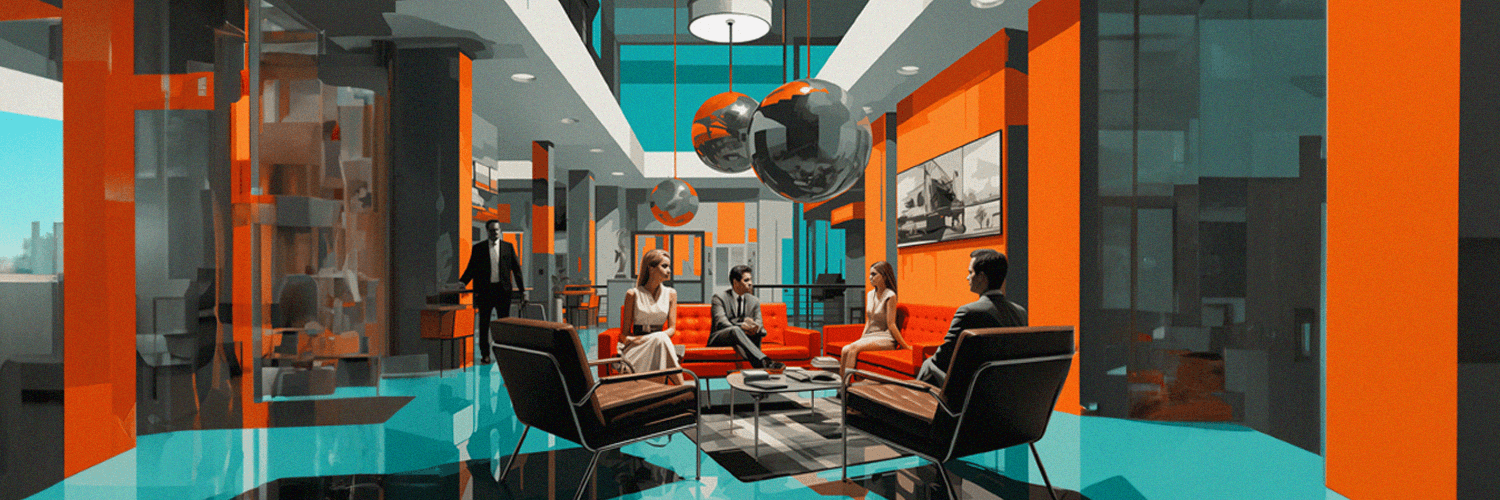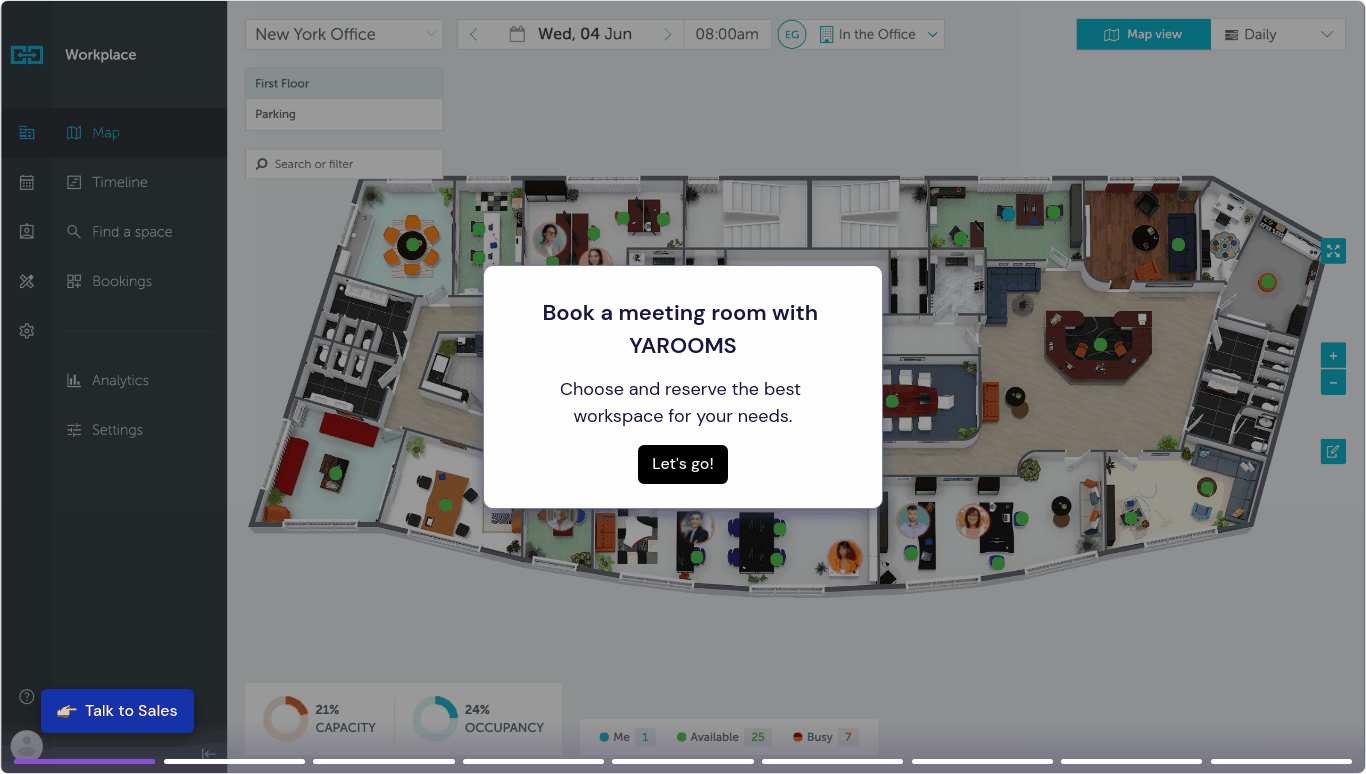Imagine entering a meeting room where colleagues argue over scheduling and space usage. You may have also experienced frustration when your important presentation got interrupted due to double bookings.
How to prevent such distractions that disrupt productivity and hamper the overall efficiency of an organization? The solution lies in a thoroughly planned, well-communicated meeting room policy. Read on if you'd like to create a harmonious work environment for all employees while ensuring maximum utilization of your company's meeting rooms.
TL;DR:
- A well-planned meeting room policy is essential for maximizing productivity and creating a harmonious work environment.
- The meeting room policy should outline guidelines for reservation, usage, and conduct within meeting spaces to streamline scheduling and ensure fair allocation.
- Poor meeting room policies lead to disputes over availability, while effective ones promote focus, punctuality, and resource optimization.
- Challenges include striking a balance between flexibility and structure, gaining stakeholder buy-in, and adapting to organizational changes.
- Every meeting room must serve its intended purpose effectively to avoid wasted resources and confusion during bookings.
- A robust room booking system is key to success, offering a user-friendly interface, real-time updates, and integration with collaboration tools.
- Monitoring and adjusting the meeting room policy regularly helps ensure its effectiveness in solving previous challenges.
- Gathering employee feedback through surveys, focus groups, and one-on-one meetings aids in continuous improvement.
- A well-crafted meeting room policy, informed by feedback and powered by an advanced booking system, fosters an efficient and respectful work environment.
Meeting Room Policy: A Short Definition
A meeting room policy is a concise set of guidelines and rules established by an organization to manage the reservation, usage, and conduct within meeting spaces. This policy aims to streamline the scheduling process, ensure fair allocation of rooms, and promote a productive environment for everyone in the organization. A meeting room policy may outline booking procedures, specify time limits, and address potential scheduling conflicts or double bookings. Additionally, the policy may address equipment or technology usage requirements and expectations for maintaining cleanliness and tidiness. Ultimately, the meeting room policy is a valuable tool to enhance efficiency and collaboration in the office.
-1.png?width=928&height=523&name=Blog%20post%20photos%202%20(3)-1.png)
Why Do You Need a Meeting Room Policy?
A meeting room policy is crucial for several reasons— primarily because it helps eliminate confusion and potential disputes about who should be using these spaces and when. Poor meeting room policies often lead to unproductive arguments between employees over availability. Establishing meeting or conference room usage and reservation guidelines can greatly alleviate such problems.
Additionally, sound policies around meeting room usage maintain an organized environment that promotes focus, creativity, punctuality, and fairness among teams. Moreover, a robust meeting room policy ensures that facilities and resources are optimally utilized, minimizing waste and maximizing productivity.
The Scope of a Meeting Room Policy
A successful meeting room policy should encompass a comprehensive framework that governs the reservation, usage, and conduct within meeting spaces within an organization. It should address the essential aspects of scheduling, equitable allocation of rooms, and ways to prevent conflicts or double bookings. The meeting room policy should also outline guidelines for maintaining a productive and respectful environment during meetings, emphasizing punctuality, tidiness, and adherence to technology and equipment usage requirements.
By defining these rules, the policy ensures all employees have equal access to meeting facilities. Furthermore, the policy promotes collaboration, creativity, and engagement during meetings, improving team dynamics and overall organizational success.
Challenges to Creating a Meeting Room Policy
Creating a meeting room policy comes with its fair share of challenges that organizations must navigate to ensure success. One of the primary challenges is striking the right balance between flexibility and structure. Organizations need to define clear guidelines and rules while accommodating the diverse needs of teams and departments. Additionally, gaining buy-in from all stakeholders can be a hurdle, as different groups may have varying preferences and requirements.
Ensuring effective communication and obtaining employee feedback during the meeting room policy formulation is crucial to address potential concerns and create a policy that resonates with everyone. Another challenge lies in the dynamic nature of organizations, as meeting room policies must evolve and adapt to changing requirements, growth, and technology advancements. Regularly reviewing and updating the policy becomes essential to maintain its relevance and effectiveness over time.
Furthermore, implementing a new meeting room policy requires a cultural shift within the organization, which may encounter resistance from those accustomed to old practices. Overcoming these challenges demands thoughtful planning, open communication, and a commitment to continuous improvement.
With 31 hours spent in unproductive meetings per month and 67% of meetings seen as failures by executives, addressing these challenges is crucial for improving overall organizational efficiency.
Before You Start: Every Meeting Room Must Have a Purpose
To ensure maximum efficiency in your office, it's essential that each available space, including meeting rooms, serves its intended purpose effectively. For example, consider utilizing smaller huddle rooms instead of using large conference rooms with high-tech features for two-person discussions. You can avoid wasting resources by considering the needs and capacities of different meetings.
Incorporating these considerations into your meeting room policy will improve booking procedures, reducing last-minute scrambles and unnecessary rescheduling caused by uninformed reservations. It will prevent chaos and confusion during meetings, making the whole process smoother and more productive. Taking these simple but powerful steps during the policy formulation stage can significantly impact optimizing space and resources in your office.

10 Steps to Creating A Winning Meeting Room Policy
Creating a successful meeting room policy involves careful planning and consideration to ensure smooth and productive interactions within your organization. Follow these ten essential steps to develop a winning meeting room policy that fosters efficiency, collaboration, and a positive work environment.
- Assess needs: understand your teams' and departments' diverse meeting requirements. Identify the types of meetings held, their frequency, and the capacity needed.
- Determine room types: categorize meeting rooms based on size, equipment, and functionality. Differentiate between large conference rooms, huddle rooms, and specialized spaces.
- Define the booking process: establish a clear and straightforward process for reserving meeting rooms, outlining who can book, how far in advance, and any necessary approvals.
- Allocation rules: set fair allocation rules to ensure equitable access to meeting spaces, considering team sizes, seniority, and the nature of meetings.
- Time limits: determine appropriate time limits for different room types, preventing meetings from running over and facilitating timely transitions.
- Technology guidelines: specify technology and equipment usage protocols to avoid disruptions and ensure a seamless meeting experience.
- Conduct guidelines: promote a respectful and focused meeting atmosphere by outlining conduct expectations for participants.
- Room accessibility: ensure meeting rooms are easily accessible to all employees, including those with mobility challenges or special needs. Strategically locate rooms throughout the workspace, consider proximity to common areas and team clusters when assigning meeting spaces.
- Communication: effectively communicate the policy to all employees, providing clear instructions and raising awareness about its importance.
- Regular review: continuously evaluate the policy's effectiveness and adapt it to accommodate changing requirements and organizational growth.
By following these steps, your organization can create a well-structured meeting room policy that enhances collaboration, minimizes conflicts, and contributes to overall productivity and success.
The Key To Every Successful Meeting Room Policy: Room Booking System
Implementing a robust room booking system is the key to every successful meeting room policy. A well-designed and user-friendly booking system is essential for the efficient and streamlined scheduling of meeting spaces within an organization.
Using a centralized room reservation platform, employees can quickly check availability, book the most suitable space for their specific requirements, and avoid conflicts or double bookings. This systematic approach fosters a collaborative and organized work environment where teams can plan meetings and ensure the resources and facilities are readily available. Moreover, the room booking system enables effective resource allocation, maximizing the utilization of meeting spaces.
Regular monitoring and improvements to the system ensure its relevance and effectiveness, catering to the evolving needs of the workforce and reinforcing a culture of efficiency and professionalism.
What to Look For in a Room Booking System?
You should consider several essential features when considering a meeting room booking system:
- Firstly, the system should offer a user-friendly interface, allowing employees to view room availability and book spaces without complications easily.
- It should also support real-time updates to avoid double bookings and maintain accuracy.
- Integration with calendar applications or workplace collaboration tools (for example, Microsoft Teams) helps streamline communication and keep participants informed about scheduled meetings.
- Flexibility in customizing booking rules and time limits allows tailoring the system to the organization's specific needs.
- Interactive office maps take room booking to another level by enabling employees to easily visualize their immediate surroundings with intuitive navigation options.
- Compatibility with digital signage applications can help your teams and visitors navigate the office with real-time information about what’s booked, what’s free, and when meetings take place.
- Advanced reporting and analytics can provide valuable insights into room usage patterns, aiding in resource optimization.
- Security measures to protect sensitive data and access control are also critical considerations.
By prioritizing these features, a well-rounded meeting room booking system can significantly enhance productivity and efficiency in the workplace.
Discover YAROOMS room booking software — press the image to watch. 👇
Real-Life Example: Successful Meeting Room Policy Powered by a Booking System
Columbia University, a renowned research and education center, faced a significant challenge with its meeting room management before partnering with YAROOMS. Each faculty building had its administrative staff handling separate booking processes, leading to inefficiencies and frequent overlapping meetings. The need for a unified approach made coordinating bookings through calls or emails time-consuming and challenging to track. To address these issues, YAROOMS provided a single, user-friendly hub that empowered university staff to find and book the fitting room anywhere on campus within minutes.
The adoption of YAROOMS yielded remarkable results for Columbia University:
- 28 buildings.
- 178 rooms.
- 110 000, or 43 years' worth of meetings.
- 100% reduction in booking conflicts.
- 18 000 hours (2 years!) saved with efficient scheduling.
YAROOMS proved to be a stable and user-friendly solution swiftly adopted by the institution's end-users across various divisions. The successful integration of the booking system has brought much-needed agility and autonomy to the university's staff, streamlining meeting room bookings and significantly improving overall efficiency.
This real-life example demonstrates how an effective meeting room policy, powered by an advanced booking system like YAROOMS, can transform the meeting management process, enhance productivity, and optimize valuable resources in any organization.
How to Evaluate the Success of Your Meeting Room Policy?
Before evaluating a meeting room policy's effectiveness, it's crucial to understand that achieving efficiency may take time and persistence. Monitoring and adjusting the policy regularly are necessary for success.
Start by objectively assessing how your company's meeting rooms are being used. Collect data on peak times, booking frequency, and space preferences. These patterns will guide future improvements to your policy and booking system.
Next, consider the original issues your policy aimed to solve, like double bookings or no-shows. Compare past challenges with the present situation to see if the policy has made a positive impact.
Also, pay attention to how employees behave in meeting rooms after the policy's implementation. Are they treating the spaces respectfully and following the established guidelines? Observing these behaviors provides valuable feedback on the policy's effectiveness.
Additionally, use specific key performance indicators (KPIs) to measure meeting room utilization. Metrics like average booking duration, occupancy rates, and late cancellations can track improvements resulting from the policy.
Remember, the ultimate goal is not just enforcing rules but creating efficient meeting rooms and shared resources management. Consistent monitoring and adjustments will lead to a successful meeting room policy that benefits the organization.
Collecting Employee Feedback and Improving the Policy
Crafting an exceptional meeting room policy doesn't stop once you've created it. Like any other aspect of your company, continuous improvement is crucial. One effective method for refining your meeting room policy involves collecting feedback from those that interact with it regularly — your employees. Here are some ways to do this:
- Anonymous surveys: conduct anonymous surveys to encourage honest and candid responses. Ask employees about their experiences with the meeting room policy, any challenges, and suggestions for improvement.
- Focus groups: organize focus groups with representatives from different departments to delve deeper into specific issues and better understand their needs and concerns.
- One-on-one meetings: conduct one-on-one conversations with employees to gain personalized insights. This approach allows for a more in-depth exploration of individual experiences with the meeting room policy.
- Suggestion box: implement suggestion boxes (maybe in the most popular meeting rooms?) where employees can drop written feedback or ideas, providing an alternative channel for sharing their thoughts.
- Monitor data and metrics: regularly analyze data related to room bookings, cancellations, and usage patterns to identify any recurring issues or potential bottlenecks.
- Stay open to input: encourage employees to share feedback through various channels, such as emails or an internal communication platform, so they can comfortably express their opinions.
Remember, creating a receptive and non-judgmental atmosphere is crucial when seeking feedback. Ensure employees understand that their input is valued and will be used to improve the meeting room policy for the benefit of everyone. By continuously seeking and incorporating employee feedback, you can transform your meeting room policy into an ever-evolving and effective tool that optimizes productivity and fosters a harmonious work environment.
Wrapping Up
Creating a winning meeting room policy requires careful planning, continuous improvement, and a focus on meeting your organization's and its employees' needs. A well-defined policy, complemented by an efficient room booking system, lays the foundation for a harmonious work environment and optimal resource utilization.
To evaluate the success of your policy, objectively assess room usage, compare past challenges with present conditions, and monitor employee behavior in meeting rooms. Key performance indicators related to meeting room utilization provide valuable insights into improvements resulting from the policy.
Seeking feedback from employees is crucial for continuous improvement. Utilize anonymous surveys, focus groups, one-on-one meetings, and suggestion boxes to gather insights and suggestions for policy refining. Emphasize the importance of open communication to create a receptive atmosphere for sharing feedback.
A well-crafted meeting room policy, powered by a robust booking system and informed by employee input, fosters an efficient, collaborative, and respectful work environment. By consistently seeking improvements, organizations can ensure that their meeting room policy remains dynamic and effective, supporting the success of the entire workforce.













